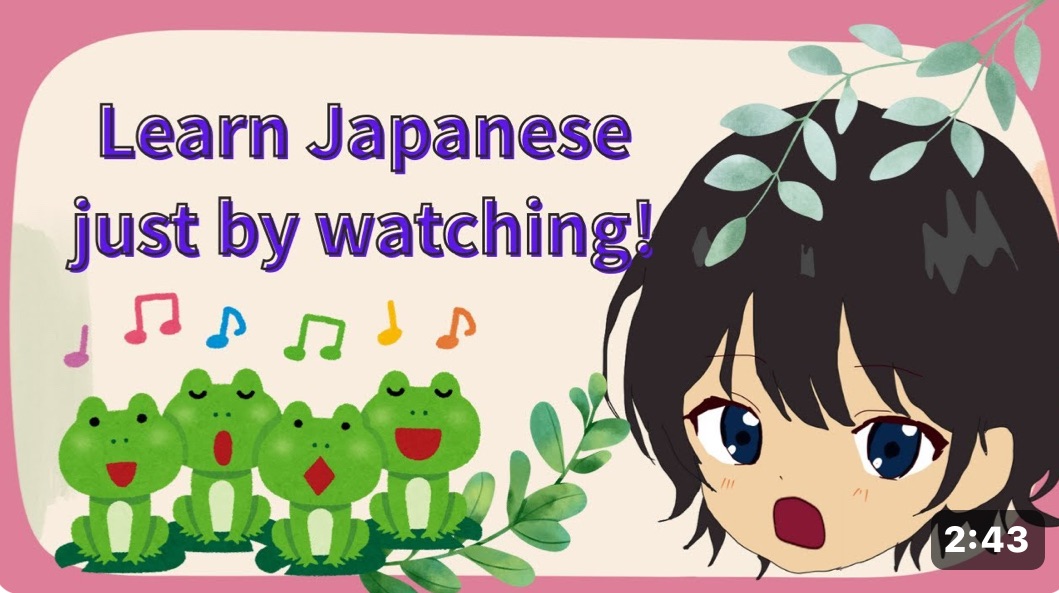This is a commentary article for the YouTube video released on 2025.6.5.「かえるのうた」 appears in the video.
Hello everyone.
In this article, I’ll explain the Japan Phrase Adventure YouTube video released on 2025.6.5.
If you haven’t seen it yet, please watch it from the link below.
Here is the script from this YouTube video:
「これはなに?」
「くま!」
「そう。くま!これは何色(なにいろ)?」
「茶色(ちゃいろ)」
「そう。茶色。ちゃいろ!これは?これはなに?」
「葉っぱ!(はっぱ)」
「葉っぱ!!?うーん、ちょっと違う(ちがう)かなあ。葉っぱはこっち。これが、葉っぱ。これは、かえる。かえるさんだよ〜」
「かえるのうたが きこえてくるよ
くわくわくわくわ
けけけけけけけけ
くわくわくわ」
「かえると葉っぱ どっちも緑色。おなじだね。カエル(かえる)も葉っぱも、緑色(みどりいろ)」
end
My youtube https://youtu.be/fcPqkuJSXcQ
Now, let’s begin the explanation.
So everyone! Have you learned how to read ひらがな?
So everyone! Have you learned how to read ひらがな?
Although I include ローマ字 (romaji) as a supplement, in real Japanese we don’t use romaji.
It’s only added to help people from overseas read more easily.
That’s why I hope you will learn to read ひらがな as much as possible.
If you’re not confident with ひらがな yet, please start by mastering it.
Some ひらがな look quite similar, and depending on the font, the appearance can change slightly, which can be tricky.
But don’t worry — as you’re exposed to more Japanese, you’ll start to recognize them.
If you haven’t mastered the ひらがな50音 yet, please visit this page:
Also, be careful with the particle「は」that comes right after the subject — it’s an irregular case.
Although written as “ha”, it’s read as “wa”!
「これはなに?」→「ko re wa na ni?」
🌟Key points in this video
1. 何色? (なにいろ)
When asking about color, say「何色?」. To make it more polite, add「ですか?」and say「何色ですか?」
Example situations where you can use it:
・When your friend says they bought a new car, and you want to ask what color it is.
・When you’re lost and on the phone with a friend, and they tell you to turn at a big signboard — you want to ask what color the sign is.
・When someone dropped their wallet and you want to ask what color it is.
2. 違う(ちがう)
「違う」is used when something is wrong, mistaken, or different.
Example situations where you can use it:
・Someone finds a wallet and asks you, “Is this yours?” But,that’s not yours.
・Your friend says, “You live in Tokyo, right?” but you actually don’t.
3. 同じ(おなじ)
「同じ」means “the same.” In spoken language, it’s sometimes pronounced as「おんなじ」with an “n” sound — both are OK. However, in formal documents,「同じ」is more appropriate than「おんなじ」.
(In the video, I made a mistake in the romaji: I pronounced it「おなじ」, but wrote it as「おんなじ」. Sorry!)
Example situations where you can use it:
・You and your friend are from the same hometown.
・You like the same manga.
・You’re the same age as someone else.
That concludes the explanation.
As for the other words like「かえる」and「みどり」, I believe you can understand them well enough from the video, so I’ll skip those here.




